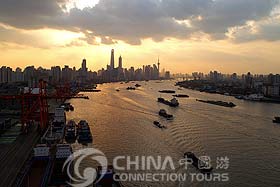
 As one of the four municipalities under the direct jurisdiction of the central government, Shanghai is China's leading industrial and commercial city and major financial center, as well as a historical and cultural city. The policy of reform and opening up to the outside world has transformed Shanghai into a sophisticated metropolis with a well-developed network of land, air and sea transportation.
As one of the four municipalities under the direct jurisdiction of the central government, Shanghai is China's leading industrial and commercial city and major financial center, as well as a historical and cultural city. The policy of reform and opening up to the outside world has transformed Shanghai into a sophisticated metropolis with a well-developed network of land, air and sea transportation.
Shanghai city proper has a total area of 6,340.5 square kilometers. It extends about 120 kilometers from north to south and nearly 100 kilometers from east to west. Bordering on Jiangsu and Zhejiang Provinces on the west, Shanghai is washed by the East China Sea on the east and Hang Zhou Bay on the south. North of the city, the Yangtze River pours into the East China Sea. It has a central location along China's coast line. Except for a few hills lying in the southwest corner, most parts of the Shanghai area are flat and belong to the alluvial plain of the Yangtze River Delta. The average sea level elevation is about four meters.
 Dotted with many rivers and lakes, the Shanghai area is known for its rich water resources, with the water area accounting for 11% of its total territory. Most of the rivers are tributaries of the Huangpu River that flows through downtown Shanghai. With a pleasant northern subtropical maritime monsoon climate, Shanghai enjoys four distinct seasons, generous sunshine and abundant rainfall every year. Spring and autumn are relatively short compared with the summer and winter. The average annual temperature is 17.6 Co. The city had a frost-free period of 300 days a year, and received an average annual rainfall of 1,302 millimeters. Nearly 50% of the precipitation comes during the May-September flood season, which is divided into three rainy periods, called, the Spring Rains, the Plum Rains and the Autumn Rains.
Dotted with many rivers and lakes, the Shanghai area is known for its rich water resources, with the water area accounting for 11% of its total territory. Most of the rivers are tributaries of the Huangpu River that flows through downtown Shanghai. With a pleasant northern subtropical maritime monsoon climate, Shanghai enjoys four distinct seasons, generous sunshine and abundant rainfall every year. Spring and autumn are relatively short compared with the summer and winter. The average annual temperature is 17.6 Co. The city had a frost-free period of 300 days a year, and received an average annual rainfall of 1,302 millimeters. Nearly 50% of the precipitation comes during the May-September flood season, which is divided into three rainy periods, called, the Spring Rains, the Plum Rains and the Autumn Rains.
Shanghai has a population of 17 million (including the floating population). The main inhabitants are Han nationality. The main religion here is Buddhism and Taoism.
Shanghai began as Huating County, an administrative district established in 751 AD. In 991 AD, Shanghai Town was set up in the county. During the period of 1260A.D-1274 A.D, the town evolved into an important trading port. In 1292A.D, the central government approved the establishment of Shanghai County, which has been widely deemed as the official beginning of the city of Shanghai.
In the 16th century, Shanghai became the national center of the textile industry. In 1685, Shanghai, that already had a population of 200 thousand, set up its first customs office. After the Opium War in the mid-19th century, Shanghai served as a major trading port and gateway to inland China. With the invasion of the western powers Shanghai became a semi-feudal and semi-colonial city until the year of 1949 when the People's Republic of China was founded.

